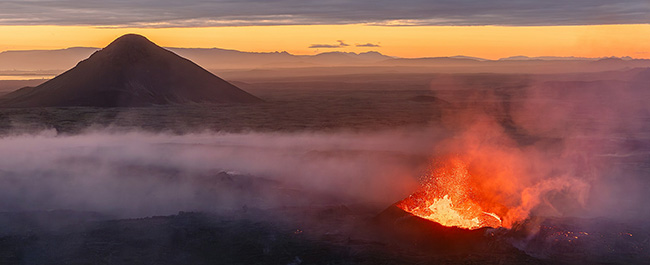Reducing the risk of volcanic ash to aviation

Research at Bristol has led to safer air travel and many more benefits for the aerospace industry, airlines, airspace management and the military.
Research highlights
- Enabled Rolls-Royce to define how planes fly can safely through volcanic ash clouds
- Built new methods and tools to improve ash forecasting and monitoring now used by Volcanic Ash Advisory Centres around the world
- Advised NATO on safe military operations, not only in ash clouds but also in other dusty environments to reduce risk to personnel
Responding to crisis
When the Eyjafjallajökull volcano erupted in Iceland in 2010, it injected huge quantities of ash high into the atmosphere and posed a severe hazard to aircraft.
The impact on UK air operations was unprecedented, with an extended closure of airspace, the cancellation of more than 100,000 flights and an estimated economic loss across all sectors of $5 billion.
In response, University of Bristol research has led to safer air travel and formalised the possibility of flights in volcanic ash contaminated airspace.
It has also helped to supplant the old and costly procedure of avoiding ash at all costs.
Collaboration with Rolls-Royce
Triggered by the 2010 crisis, Rolls-Royce approached Bristol’s researchers to work on a collaborative project that aimed to minimise aviation disruption caused by volcanic clouds whist maintaining high safety requirements.
Subsequent work by Bristol’s experimental petrology group tested the behaviour of a range of volcanic materials with engine components at high temperatures.
This demonstrated that the nature of volcanic ash (median grain size and composition) strongly affects its transport and deposition and its harmful effects on the engine.
The results also indicated that ash with lower silica content and finer ash particles are more likely to stick to engine parts.
Silicic ash, on the other hand, tends to form cindery deposits which are more likely to self-clean.
Following the completion of this stream research in 2017, Rolls-Royce published a technical note which established for the first time for any engine manufacturer the conditions in which their engines can tolerate ash - ultimately leading to a 2018 UK Civil Aviation Authority Flight Safety Award.
Rolls-Royce was the first engine manufacturer in the world to achieve this. As a result, it became the only engine supplier certified to operate in volcanic ash.
The company said that this would save the aviation industry “10s of £millions annually” through reduced disruption and better maintenance regimes.
Volcanic ash modelling
Further research by the Bristol team has looked at volcanic ash dispersion models, which are crucial in forecasting ash clouds for aviation hazard management and are used by all nine Volcanic Ash Advisory Centres (VAACs).
Breakthroughs have included the development a free web tool, PlumeRise, which gives more accurate estimates of the amount of ash injected into the atmosphere during a volcanic eruption because, uniquely, it properly accounts for the effect of the atmospheric state and wind.
This reduces the risk of underestimating the amount of ash released, and also the extent of airspace containing ash which would compromise the management of airspace.
Eight of the nine VAAC regions now use PlumeRise model, including the London, Darwin and Buenos Aires VAACs and the Icelandic Met Office.
The Darwin VAAC, for example, runs a local version that it uses for monitoring Indonesian airspace - one of the world’s busiest for flights but with a high density of active and ash-producing volcanoes.
The Darwin VAAC has used the model operationally many times each year, including for activity from Krakatau in Indonesia and Ulawun in Papua New Guinea in 2020.
Wider impact
Bristol’s work on volcanic ash has also impacted military operations.
In 2018 NATO invited the team to co-author a technical report that defines NATO’s position on safe military operations in hostile environments (including desert dusts and sea salt, as well as volcanic ash).
The Bristol team led the section of the report which details the current state of the art in satellite remote sensing observations, dispersion modelling and data assimilation, helping to define research and development priorities on safe operations in contaminated environments for the 28 countries within NATO.
Bristol’s research is also informing national responses to volcanic eruptions and has minimised economic and societal disruption.
In 2017, for example, the researchers ran a workshop to disseminate its findings with the Guatemalan Civil Aviation Directorate.
The team provided training to over 40 air traffic control staff, which ultimately ensured that La Aurora airport largely stayed open during the major eruption of the Fuego volcano in 2018.
As Guatemala’s only international airport, La Aurora is a vital transport hub for the whole country and was a critical entry point for overseas aid after the disaster.
Award winning research
The University of Bristol research team was awarded the Queen’s Anniversary Prize in 2015 for its “outstanding research into the risks posed by volcanoes to aviation.”
The Queen’s Anniversary Prizes were granted by the Monarch every two years for “outstanding work by UK colleges and universities that shows quality and innovation and delivers real benefit to the wider world and public through education and training.”
Following the completion of this stream research in 2017, Rolls-Royce published a technical note which established for the first time for any engine manufacturer the conditions in which their engines can tolerate ash.
Meet the researcher
Dr M J Woodhouse, NERC Knowledge Exchange Fellow, School of Earth Sciences
Professor Andrew J Hogg, Professor of Fluid Mechanics, School of Mathematics
Cite the research
- Woodhouse MJ, Hogg AJ, Phillips JC, Sparks RSJ. (2013). Interaction between volcanic plumes and wind during the 2010 Eyjafjallajökull eruption, Iceland J. Geophys. Res. 118, 92-109. doi: 10.1029/2012JB009592
- Woodhouse MJ, Hogg AJ, Phillips JC, Rougier JC. (2015). Uncertainty analysis of a model of wind-blown volcanic plumes. Bull. Volcanol. 77, 83. doi: 10.1007/s00445-015-0959-2
- Woodhouse MJ, Hogg AJ, Phillips JC. (2016). A global sensitivity analysis of the PlumeRise model of volcanic plumes J. Volcan. and Geotherm. Res. 326, 54-76. doi: 10.1016/j.jvolgeores.2016.02.019